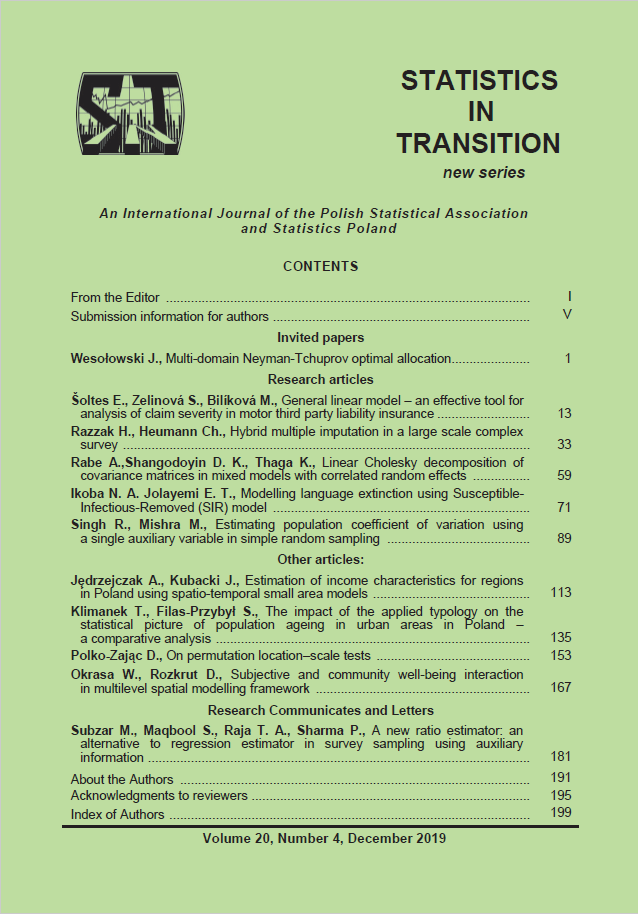ARTICLE
ABSTRACT
Analysing the cross-level interaction between individual and community well-being requires a joint involvement of both 'vertical' and 'horizontal' perspectives. While multilevel modelling separates the effects resulting from personal characteristics from those resulting from community features, the need to account for spatial variation and geographic membership proves that space and place matter, too. In this paper, the explicitly-spatial multilevel model has been developed to this effect, namely to identify both types of effects, space and place-related, using the hierarchical (nested) data structure for the smallest administrative units – NUTS5/LAU2, i.e. communes (gminas). In their analysis, the authors employed two methods for measuring well-being: (i) individual (subjective) well-being measure derived from the nation-wide Time Use Survey data, which they occasionally replaced with 'life satisfaction' type of self-reported measures, and (ii) multidimensional index of local deprivation composed of eleven domain-scales. The spatial multilevel modelling has been extended by an attempt to assess what effect spatial interaction has on cross-level relationships. Its inclusion in the discussion with which this paper concludes seems recommendable, as it indicates the need for more systematic efforts towards a spatially-integrated approach to this kind of modelling problems.
KEYWORDS
spatial analysis, measuring subjective well-being, community deprivation, social capital
REFERENCES
ALKIRE, S., (2015). The Capability Approach and Well-Being Measurement for Public Policy, Oxford Poverty & Human Development Initiative Working Paper No. 94.
ANAND, P., MONTOVANI, I., (2018). The Value of Individual and Community Social Resources, In New Frontiers of the Capability Approach (eds.) F, Fennell S, and Anand, PB Cambridge U. Press.
ARCAYA, M., BREWSTER, M., ZIGLER, C M., SUBRAMANIAN, S. V., (2012). Area variations in health: A spatial multilevel modeling approach, HEALTH PLACE. 2012 JUL, 18(4), pp. 824–831.
CLARK, A. E., (2018). Four Decades of the Economics of Happiness: Where Next? Review of Income and Wealth. Volume 64, Issue 2, https://doi.org/10.1111/roiw.12369
DOLAN, P., LAYARD, R., METCALFE, R., (2011). Measuring Subjective Wellbeing for Public Policy: Recommendations on Measures, 23 Report to the ONS. Special Paper No. 23.
EASTERLIN, R. A., (2010). Happiness and Economic Growth: Does the Cross Section Predict Time Trends? Evidence from Developing Countries [in] Diener E., Kahneman D., Helliwell J., (eds.), International Differences in Well-Being. Published to Oxford Scholarship Online: May 2010, DOI: 0.1093/acprof:oso/9780199732739.001.0001.
FISCHER, M. M., GETIS, A., (eds.), (2010). Handbook of Applied Spatial Analysis: Software Tools, Methods and Applications. Springer.
HELLIWELL, J. F., C. P., BARRINGTON-LEIGH, A., HARRIS, H., HUANG, (2010). “International evidence on the social context of well-being” in E. Diener, J. F. Helliwell and D. Kahneman, eds. International Differences in Well-Being (New York: Oxford University Press).
HONG, G., (2015). Causality in a Social World: Moderation, Mediation and Spill-over, Wiley.
HOX, J. J., MOERBEEK, M., VAN DE SCHOOT, R., (2017). Multilevel Analysis: Techniques and Applications, Third Edition. CRC Francis & Taylor, https://www.crcpress.com/Multilevel-Analysis-Techniques-and-Applications.
KAHNEMAN, D., KRUEGER, A. B., (2006). Developments in the measurement of subjective well-being, Journal of Economic Perspectives, 20, pp. 3–24.
KALTON, G., MACKIE, CH., OKRASA, W., eds., (2015). The Measurement of Subjective Well-Being in Survey Research, Statistics in Transition new series. Vol. 16, No. 3.
KIM, Y., LUDWIGS, K., (2017). Measuring Community Well-Being and Individual Well-Being for Public Policy, In: R. Phillips & C. Wang (eds.), Handbook Of Community Well-Being Research, Springer.
LLOYD, C. D., (2011). Local Models For Spatial Analysis. CRC Press Taylor & Francis Group.
OKRASA, W., (2017). Community well-being, Spatial Cohesion and Individual well-being – towards a multilevel spatially integrated framework, In: W. Okrasa (Ed.) Quality of Life and Spatial Cohesion: Development and well-being in the Local Context, Cardinal Stefan Wyszynski University Press, Warsaw.
OKRASA, W., ROZKRUT, D., (2018). The Time Use Data-based Measures of the Wellbeing Effect of Community Development. Proceedings of the FCSM2018/Federal Committee on Statistical Methodology Research Conference. [in press].
PATUELLI, R., ARBIA, G., (Eds.), (2016). Spatial Econometric Interaction Modelling, Springer.
STIGLITZ, J., A., SEN, J.-P., FITOUSSI, (2009). Report by the Commission on the Measurement of Economic and Social Progress (Paris), www.stiglitz-sen-FITOUSSI.FR
SUBRAMANIAN, S. V., (2010). Multilevel Modeling [in] Fischer and Getis (2019).
